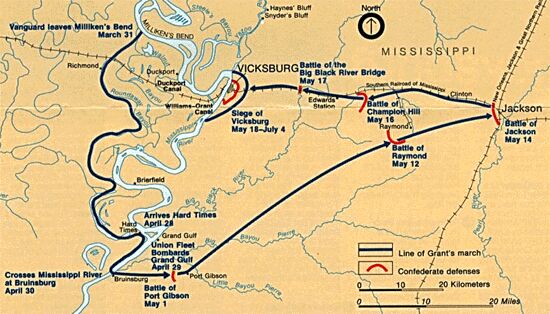Part I:
“Vicksburg is the key.”

Vicksburg, Mississippi
Union President Abraham Lincoln:
"Vicksburg is the key. The
war can never be brought to a close until the key is in our pocket. We can take
all the northern parts of the Confederacy, and they still can defy us from
Vicksburg. It means ... fresh troops from the states of the far south, and a
cotton country where they can raise the staple without interference."
Confederate President Jefferson
Davis:
"Vicksburg is the nail-head
that [holds] the South's two halves together."
Union General U. S. Grant:
"Vicksburg was important to the enemy because it occupied the first high ground coming close to the river below Memphis. From there a railroad runs east, connecting with other roads leading to all points of the Southern States. A railroad also starts from the opposite side of the river, extending west as far as Shreveport, Louisiana. Vicksburg was the only channel (at this time) connecting the parts of the Confederacy divided by the Mississippi. So long as it was held by the enemy, the free navigation of the river was prevented. Hence its importance."
***
Union President Abraham Lincoln realized that Vicksburg
was essential to winning the war in the west and made this his priority as he
and his advisors began their strategy to divide and conquer the Confederacy in
1862. And so early that year the Federal army began pushing south toward
Mississippi.
First came the victories on the middle Mississippi River, and into Kentucky. Another Union push resulted in the first major win in the west, at Fishing Creek, Kentucky, on
January 19. This led to the eventual
control of all Kentucky and gave the Union the momentum and open door to now move south into
north middle Tennessee where they captured Fort Henry and then Fort Donelson in
February. A young officer, Ulysses S. Grant, began making a name for himself
when he demanded -- and got -- an "Unconditional Surrender" at Fort
Donelson.
By early April the Federal forces moved down the
Tennessee River where Grant began massing his troops near Pittsburg Landing
(Shiloh), on the southern edge of west Tennessee. On April 6-7 he would win the
Battle of Shiloh -- the first big clash of major armies in the west. But
Grant’s losses were heavy and he drew much criticism for his handling of this
fight. General Halleck stepped in and moved the Union forces a few miles south
to the rail center of Corinth, Mississippi, where they began to build their
supply base. Grant was basically idle during Halleck's intervention, but soon
Halleck was called back to Washington and at this time Grant resumed active
commannd.
In October of 1862 the Confederates moved back to northeast Mississippi trying to regain control and prevent any further push into the state. Here, CSA General Sterling Price attacked Iuka, and although both sides claimed victory, it was the Union that benefited. General Earl Van Dorn then attacked Union General Rosecrans at Corinth, and after a long and bloody fight, the Federals held off the rebel assault and remained in control of the city. With north Mississippi now firmly under Union control, the rebel army soon began to move south where they began building defense works on the Tallahatchie River, just above Abbeville.

General Ulysses S. Grant
With a string of key victories in his pocket, Grant soon
became the top ranking Union officer in the west. Now that Kentucky, parts of
west and central Tennessee, and north Mississippi were in Union control, the
focus sharpened quickly on Vicksburg. It was the key to dividing and conquering
the Confederacy in the west, and the war department in Washington knew that
without Vicksburg the Union could never be restored.
Now that Grant was departmental leader it was assumed
that he would lead the way to Vicksburg. But John McClernand, an Illinois
politician, self-promoter, and now general, persuaded his friend Lincoln to
allow him to take an army south to capture Vicksburg in advance of Grant. Grant
was surprised and miffed that one from his own department would seek -- and
gain -- such approval without his knowledge. The war department in Washington
generally agreed with Grant, but had reluctantly acknowledged Lincoln’s
decision concerning McClernand. In response to Grant's inquiries on the matter,
the war department replied with a vague approval for him to move at his own
discretion. This was all he needed, and soon Grant began his own designs for
Vicksburg.
Grant now began to implement his Mississippi Central Railroad Campaign -- a two part strategy designed to capture Vicksburg. Grant would move down the Mississippi Central Railroad, capturing the towns and rail line along the way, until he reached the capital city of Jackson. Then he would move nearly due west to Vicksburg, destroying the rail line between those two key cities. Here he would meet Sherman who would be arriving from Memphis with the other wing of the army. Grant would arrive to the east and Sherman to the north, and they would then surround the city and, along with the Navy, capture it. Logically, the plan was sound. But tactically it would prove all but impossible.
|
March forward to: |
|
Return to Headquarters at: |